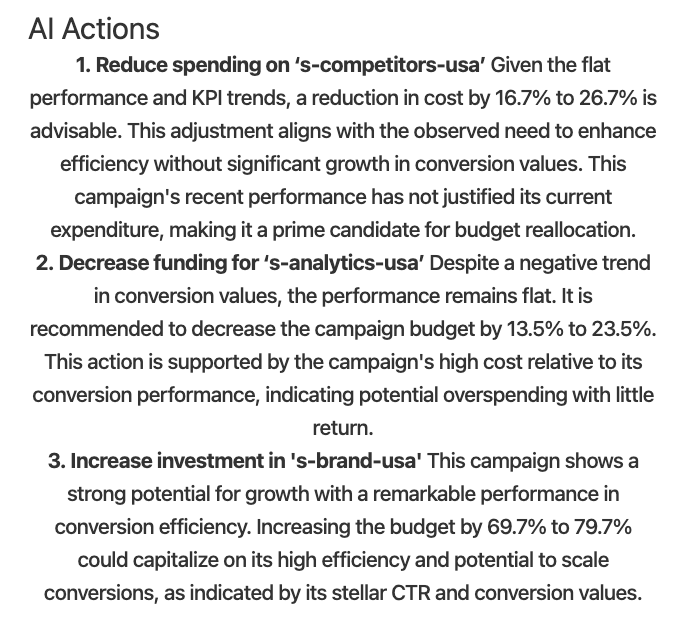Updated on
September 10, 2025
Discover how AI Actions optimize marketing campaigns through advanced AI, predictive analytics, and actionable recommendations.
Actionable Insights is a powerful tool designed to help businesses optimize their marketing campaigns through advanced AI and predictive analytics. Here’s a detailed look at how it works, explained in a straightforward manner.
The first step in using Actionable Insights is to gather data from various sources where your campaigns are running. It able to work with all data sources Improvado supported.
Once the data is collected, the next step is to transform it into a unified format: different platforms often use different names for similar metrics, for instance, metrics like clicks and visits from different platforms are unified under common terms. This standardization process allows for a coherent analysis across all platforms.
With a clean and standardized dataset, the next step is to define the specific business use case.
This involves selecting the primary metrics that are critical to your business, such as spending, revenue, or conversion rates. Performance criteria are set to evaluate the effectiveness of your campaigns.
Furthermore, you determine the granularity of the insights you need, whether it’s at the campaign level, creative level, or channel level. Defining these aspects ensures that the subsequent analysis is precisely aligned with your business goals.
All these preferences you also can set up by yourself in our performance analytics template. It is the way how to set them up in self-serve.
Now that the data is ready and the objectives are clear, Actionable Insights employs advanced AI models to analyze historical data and predict future outcomes.
These AI models are more sophisticated than basic regression models; they use neural networks that have been pre-trained on extensive marketing sales data.
This allows them to handle complex time-series predictions with high accuracy.
Alongside predictive modelling, optimization algorithms are used to determine the best ways to allocate your marketing budget across different platforms, identifying key value signals that indicate where your efforts will be most effective.
Based on the predictions made by the AI models, AI Actions generate actionable recommendations. These recommendations are presented in natural language, making them easy to understand and implement.
For instance, the AI might suggest increasing your budget on platforms that are predicted to perform well and reducing spend on those that are not.
Each recommendation comes with a predicted outcome, providing a clear rationale for the suggested actions and helping you make informed decisions to enhance your campaign performance.
Example of AI Actions:

After implementing the recommendations, it’s important to evaluate their effectiveness. We collect new data to assess the impact of the changes. The results are compared with the predicted outcomes to measure success. If there are discrepancies between the actual results and the predictions, the AI model is retrained with the new data. This continuous learning process ensures that the model becomes more accurate over time, improving the quality of future recommendations.
The primary metric for us here is the actual impact of the AI Actions. For example, if the AI suggested a budget reallocation expecting a 10% increase in conversions, we analyze whether this increase was achieved. If the actual results differ from the predictions, we identify the discrepancies and use this new data to retrain the AI model. This continuous improvement process ensures that the AI becomes more accurate over time.
Additionally, this evaluation is documented in detailed reports for our customers. These reports showcase the performance improvements achieved through Actionable Insights, providing clients with clear evidence of the value added. They highlight metrics such as cost savings and performance boosts.
AI Action goes a step further by allowing for custom training of the AI model based on individual client data. This means the AI can be fine-tuned to cater specifically to a client’s unique needs and business scenarios. By training the model on data from a specific client’s accounts and use cases, we can enhance its predictive accuracy and relevance for that particular client.
This tailored approach ensures that the recommendations are not only generally effective but also highly relevant to the specific business context of each client. It allows the AI to learn from the unique patterns and behaviours within a client’s data, leading to even more precise and impactful recommendations.
AI Action leverages advanced AI and predictive analytics to provide tailored insights that help you optimize your marketing campaigns.
By following a structured approach—collecting and standardizing data, defining business objectives, performing accurate predictions, creating actionable recommendations, continuously evaluating and improving, and custom training on client-specific data — AI Action helps you save time, allocate resources more effectively, and achieve better overall campaign performance.
Improvado team is always happy to help with any other questions you might have! Send us an email.
Contact your Customer Success Manager or raise a request in Improvado Service Desk.